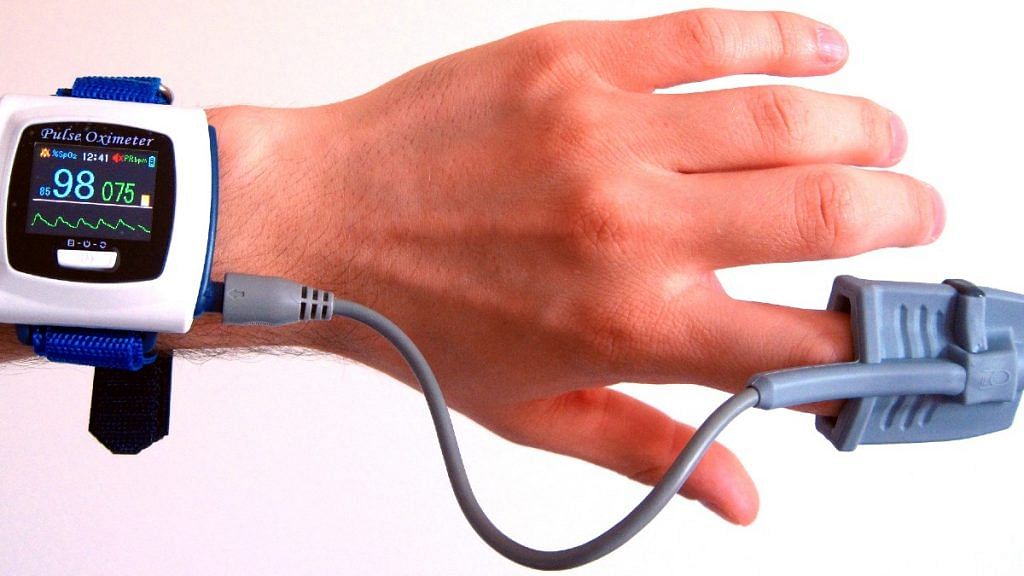New Delhi: When a 22-year-old heavily pregnant Covid-19 patient had difficulty in breathing, doctors at Jaipur’s Rajasthan University of Health Sciences (RUHS) had to first figure out whether it was due to her pregnancy or the disease.
“An X-ray could have revealed whether the patient had pneumonia but it would have (had a) harmful effect on the foetus,” said Dr Sheetu Singh who is one of the Covid-19 doctors at RUHS and an assistant professor, Institute of Respiratory Disease, SMS Medical College, Jaipur.
So, instead, the doctors used a pulse oximeter to check the woman’s blood oxygen levels. The reading showed that her levels were still normal, which meant her breathing issues were not related to the coronavirus disease.
A simple yet effective tool, pulse oximeters have been coming in handy in the treatment and management of Covid-19.
The oximeters are small clip-on devices that are commonly attached to a patient’s fingers. It has so far been used on people suffering from respiratory illnesses such as chronic obstructive pulmonary disease (COPD), lung disease, asthma and others.
The readings are taken in percentages; if between 88-95 per cent, oxygen saturation is considered normal, below 88 per cent, the patient is said to be in a state of hypoxia (low levels of oxygen) and needs immediate hospitalisation and oxygen therapy.
“For pulmonologists, oximeters and stethoscopes are very important tools,” said Singh. With stethoscopes, given its limited benefits and the tendency to spread infection, being considered less important now, oximeters have become absolutely necessary to determine which patients’ health is deteriorating.
Also read: Oxygen therapy or ventilators? Indian doctors rethink best option for critical Covid cases
Covid-19 and hypoxia
Pneumonia is a common symptom of Covid-19. It is the condition when the lungs fill up with fluid and pus, causing a person to struggle to breathe. The rapid breathing rate tires the lung muscles, which results in the level of oxygen falling while the level of carbon dioxide rises within the body.
This imbalance causes changes in the alkalinity (acidity levels) of the blood and can cause cardiac failure and death, said Singh.
Patients suffering hypoxia need to be moved to a tertiary care centre and given oxygen supply. They also need to undergo an arterial blood gas test, which records the levels of oxygen as well as carbon dioxide in the blood. This helps adjust the amount of oxygen that needs to be given to a patient.
Also read: How we’ve lost time in the race for a Covid-19 cure
Now in fever clinics
In Pulmonology, oxygen saturation levels are the fifth vital sign to be examined daily apart from pulse, blood pressure, temperature and respiratory rate. This holds true for all Covid-19 cases as well.
Fever clinics in Karnataka and Maharashtra that are being used to keep track of Covid-19 cases are now relying on oximeters to screen patients with influenza-like symptoms.
“We take a detailed clinical history of all patients, (and) those with low oxygen saturation are immediately given medical attention,” said Vijay Khabale, chief public relations officer, Brihanmumbai Municipal corporation.
“It would be advisable that they are easily available in all general practitioners clinics as well to detect hypoxia early,” said Dr Om Srivastava, infectious disease specialist, Jaslok Hospital, Mumbai.
Should you get it at home?
Quite a bit has been written about ‘Happy Hypoxia’ or silent hypoxia where Covid-19 patients do not feel the symptoms of breathlessness but have dangerously low levels of oxygen. An oximeter can help with this as it can warn such a patient on when to reach a hospital before their condition deteriorates.
Oximeters sold online for households cost about Rs 3,000 while the ones in the hospital are worth about Rs 1 lakh.
Doctors, though, say it isn’t an absolute necessity to have one at home.
“It is an interesting question but currently we aren’t seeing many cases where the levels of oxygen have gone down without symptoms,” said Dr Karan Madan, assistant professor, Pulmonary medicine, All India Institute of Medical Sciences (AIIMS), New Delhi. “We cannot recommend their use at home at the moment,” he said.
Dr Sheetu Singh agreed.
“Most Covid-19 patients who have shown signs of respiratory distress show breathlessness … it (remains) the most important symptom to look out for.”
For those who still want to have a pulse oximeter at home, remember that there are chances of faulty readings, either due to old batteries, extreme cold temperatures and application of nail paint and mehendi, Dr Singh added.
Also read: 40-paise a pill antacid is new hope to treat Covid, Modi govt wants to stock up
